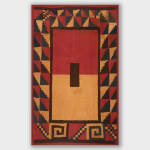Huari Culture 100 AD-1200 AD
57" x 92'1" in
Further images
The Nazca culture is known for its technically complex textiles. Textiles were woven with common motifs before they appeared painted on ceramics. The dry desert has preserved the textiles of the Nazca and Paracas cultures, which comprise most of what is known about the earliest textiles of the region. Through these works of textile art one could deduce the social rank of the wearer.
In the 20th century influential people in the art world such as Betty Parsons and Andre Emmerich were responsible for bringing these iconic pieces to the attention of artists such as Barnett Newman and Mark Rothko.
Exhibitions
Back to the Future, 40 years of Paul Hughes Fine Arts, Maiden Bradley, 2023Continuities, 2000 Years of Female Art in South America, Sala Brazil, Embassy of Brazil London, 2023
Frieze Masters, London, 2022
Confluences: 4000 years of South American Art, 2022, Cork Street, London, 2022
Our North is the South, Bergamin & Gomide, Sao Paulo, 2021.
Paul Kasmin Gallery, New York. 1995







